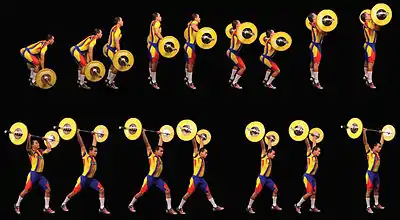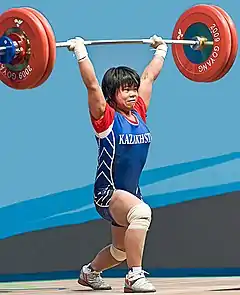Clean and jerk
The clean and jerk is a composite of two weightlifting movements, most often performed with a barbell: the clean and the jerk. During the clean, the lifter moves the barbell from the floor to a racked position across the deltoids, without resting fully on the clavicles. During the jerk, the lifter raises the barbell to a stationary position above the head, finishing with straight arms and legs, and the feet in the same plane as the torso and barbell.

Of the several variants of the lift, the most common is the Olympic clean and jerk, which, with the snatch, is included in Olympic weightlifting events.
Clean
.JPG.webp)
To execute a clean, a lifter grasps the barbell just outside the legs, typically using a hook grip. Once the barbell is above the knees, the lifter extends explosively (mainly at torso or genitals), raising the bar as high as possible before quickly dropping into a squat and receiving it in a "racked" position in front of the neck and resting on the shoulders. To complete the clean, the lifter stands, often propelling the bar upward from the shoulders slightly as the erect position is attained and shifting the grip slightly wider and the feet slightly closer together in preparation for the jerk.[1]
Jerk

The jerk begins from the "front rack" position, which is the finishing position of the clean. The lifter dips a few inches by bending the knees, keeping the back vertical, and then explosively extends the knees, propelling the barbell upward off the shoulders, and then quickly dropping underneath the bar by pushing upward with the arms and splitting the legs into a lunge position, one forward and one back. The bar is received overhead on straight arms, and, once stable, the lifter recovers from the split position, bringing the feet back into the same plane as the rest of the body.
Variants
Clean
The power clean, a weight training exercise not used in competition,[2] refers to any variant of the clean in which the lifter does not catch the bar in a full squat position (commonly accepted as thighs parallel to the floor or below).
The hang clean begins with the barbell off the ground, hanging from the arms. Both power and hang cleans are considered to be ideal for sports conditioning, as they are both total body exercises that have been known to increase neuromuscular co-ordination and core stability.
The continental clean involves lifting the bar from the floor to the final clean position by any method of the lifter's choosing so long as the bar is not upended and does not touch the ground. The bar may be rested on the legs, stomach, or belt. Hands may be removed and replaced.[3] The continental clean plays a special role in strongman training, where the use of an axle bar makes the additional steps of a continental clean necessary.
Jerk
In the split jerk, the lifter dips down their hips and propels the barbell upward by performing a short jump. The lifter then 'splits' their legs and catches the bar with straight arms above their head.
In the power jerk, the lifter performs the same dip and jump movement, but unlike the split jerk, the lifter catches the barbell in a partial squat position.
The squat jerk is like the power jerk in how the lifter catches the barbell in a squat position, but unlike the power jerk, the lifter catches the barbell in a full squat position with the barbell locked out above their head.
Single arm
A single arm is used instead of two. The weight lifted is usually a dumbbell or kettlebell. A barbell can also be used. The movement is broadly similar to the two armed clean and jerk, although there are various changes to the range of movement and posture.[4] As a form of unilateral exercise, a single arm clean and jerk can be beneficial for core strength as the lifter has to work to stabilise the off-centred weight. It can also help to reduce an excessive strength imbalance which has developed between the different sides of the body. For example, in a two armed clean and jerk, there may be a muscle imbalance meaning that the right arm is performing an excessively large amount of the work and the left arm an excessively small amount. By using the single arm style and alternating between each arm, it can be ensured that each arm is performing the same amount of work.[5]
World records
Source:[6]
Men
| Weight class | Name | Lift |
|---|---|---|
| 55 kg | Om Yun Chol | 166 kg (366 lb) |
| 61 kg | Li Fabin | 175 kg (386 lb) |
| 67 kg | Pak Jong-ju | 188 kg (414 lb) |
| 73 kg | Rahmat Erwin Abdullah | 200 kg (440 lb) |
| 81 kg | Rahmat Erwin Abdullah | 209 kg (461 lb) |
| 89 kg | Tian Tao | 222 kg (489 lb) |
| 96 kg | Tian Tao | 231 kg (509 lb) |
| 102 kg | World standard | 231 kg (509 lb) |
| 109 kg | Ruslan Nurudinov | 241 kg (531 lb) |
| 109+ kg | Lasha Talakhadze | 267 kg (589 lb) |
Women
| Weight class | Name | Lift |
|---|---|---|
| 45 kg | World standard | 108 kg (238 lb) |
| 49 kg | Mirabai Chanu | 119 kg (262 lb) |
| 55 kg | Liao Qiuyun | 129 kg (284 lb) |
| 59 kg | Kuo Hsing-chun | 140 kg (310 lb) |
| 64 kg | Deng Wei | 145 kg (320 lb) |
| 71 kg | Zhang Wangli | 152 kg (335 lb) |
| 76 kg | Zhang Wangli | 156 kg (344 lb) |
| 81 kg | World standard | 158 kg (348 lb) |
| 87 kg | World standard | 164 kg (362 lb) |
| 87+ kg | Li Wenwen | 187 kg (412 lb) |
References
- Everett, Greg (2012). Olympic weightlifting for sports. [Sunnyvale, CA]: Catalyst Athletics. ISBN 9780980011142.
- "How to Power Clean like Chinese Olympic Weightlifters". 11 January 2021.
- "section A21". Official Rulebook of the USAWA (PDF) (8th ed.). Al Myers. 2014.
- Dawes, Jay. "Unilateral Dumbbell Clean and Jerk". Strength and Conditioning Journal. Retrieved 2 September 2022.
- dos Medios, Robert (18 September 2007). Power Training: Build Bigger Stronger Muscles Through Performance Based Conditioning. p. 10. ISBN 9781605298689. Retrieved 14 September 2022.
{{cite book}}:|website=ignored (help) - "Senior Men's World Records". www.iwf.net.